Crossrail, London’s nascent rail network, officially hit the halfway mark this January: on time and on budget.
While such a claim would be a welcome distinction for any large infrastructure project — where delays and timelines so frequently slip in the face of the unexpected — Crossrail’s scope makes it doubly impressive.
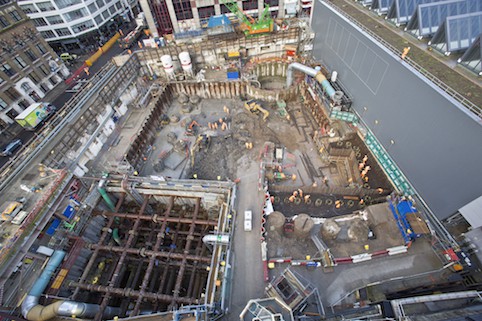
The project is vast, the largest of its kind in Europe and with a huge range of challenges across its length: from excavating 42km of tunnels through London’s complex and crowded subterranean world, to the construction of entirely new stations and infrastructure in some of the capital’s most densely packed areas.
But arguably one of the most challenging and ambitious parts of the whole undertaking is Farringdon station which, when the network opens for passengers in 2018, will become one of the city’s busiest transport hubs.
Like much of the rest of Crossrail, the scale of the work at Farringdon is obscured by the ubiquitous blue hoarding that enables most Londoners to tune out the project. But The Engineer was recently granted a rare opportunity to step backstage and take a detailed look at what Farringdon’s project manager, civil engineer Nisrine Chartouny, proudly calls ‘the heart of the network’.
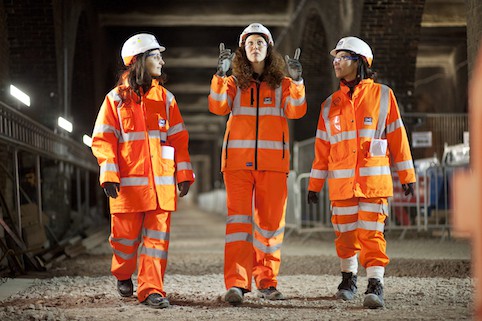
‘Geographically, we’re more or less at the centre of the underground section,’ said Chartouny, who manages the project for Bechtel, Crossrail’s delivery partner (Bam Ferrovial Kier (BFK) joint venture are the main contractors building the station). ‘Four tunnel-boring machines [TBMs] out of a total of eight will finish their journey here and it’s the only station on the network that will have a direct connection with Thameslink and London Underground lines. It’s also the only station with a direct connection to three out of five of the airports in London: Luton, Gatwick and Heathrow. If that doesn’t make it the heart of the network I don’t know what does.’
Now approaching the final stages of its civil and tunnelling work, the station consists of two ticket halls at either end of two parallel platform tunnels. One of these, at 370m long, is the longest platform on the network. These parallel tunnels are linked by a series of cross shafts and a larger circulation tunnel that sits between the two platforms.
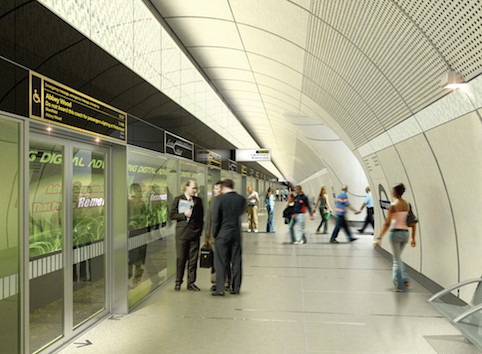
The excavations run deep. The western ticket hall (WTH) shafts go down to about 33m below street level and the eastern ticket hall (ETH) is a few metres deeper. The running tunnels and platforms are at a similar depth; way beneath the existing tube line, which is just 8m beneath the road.
One of the first steps in the construction process was digging the shafts. Indeed, the WTH shafts were actually excavated before the running tunnels arrived. This enabled Chartouny’s team to carry out preparatory work such as the removal of pre-existing piled foundations that could hinder the TBMs’ progress.
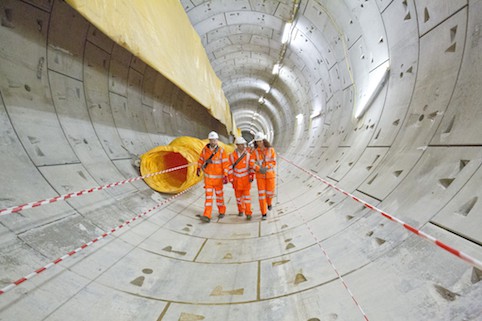
Ahead of the arrival of the arrival of the boring machines, foam concrete was injected into the excavated space in order to create a suitable cutting medium. The process was slightly different at the ETH shaft where one of the TBMs stops short of the shaft, while the other runs to the north.
The western tunnelling drive — from Royal Oak to Farringdon — was completed earlier this year, when the TBMs Phyliss and Ada (named after Phylliss Pearsall, creator of the London A to Z and computing pioneer Ada Lovelace) arrived at Farringdon from Royal Oak in the west.
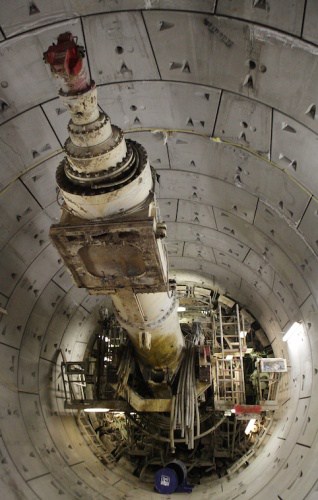
Intriguingly, despite their high cost, it was considered more economical to leave the critical components of these machines (the giant cutting heads and 10m long shields) embedded in the ground. Only the 150m-long trailer sections were retrieved. Elizabeth and Victoria, the TBMs that are digging the 8.3km Limmo to Farringdon drive, are due to reach their destination early next year and, unlike their entombed forerunners, the current plan is to retrieve them.
Chartouny’s team is now busy enlarging the station tunnels around the running tunnels. This is achieved by removing sacrificial concrete rings in the running tunnel, excavating the space behind and then spraying the new tunnel wall with concrete.
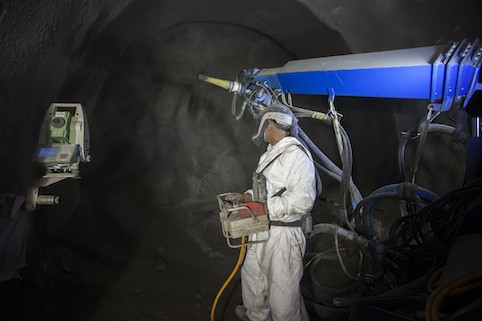
The cross tunnels joining the running tunnels and the circulation tunnel that lies between the two platforms have been built in a slightly different way, using a combination of traditional mining processes and sprayed-concrete lining techniques. This involves rapidly spraying excavated ground with concrete to stabilise it and form a permanent tunnel lining.
One of the biggest challenges throughout all of this, said Chartouny, has been predicting, monitoring and dealing with the implications of one of the Crossrail route’s most complex geological environments.
Most of Crossrail’s sub-surface route and, for that matter, the London Underground, has been built in London clay; a perfect medium for tunnelling, that’s conveniently widespread in London to depths of more than 40m.
However, at Farringdon, the ground conditions are more complex. Here, the base of the London clay formation is less than 30m below the surface and much of the station is therefore being built in the Lambeth group soil beneath the London clay. This layer, which is around 15–20m thick, is more varied in composition and can include water-saturated sand lenses which, if encountered during excavation and not properly de-pressurised, can cause instability in the tunnel.
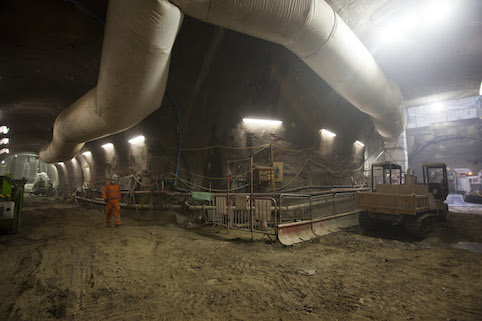
What’s more, according to geologist Dr Don Aldiss, who carried out some of the early geological modelling work for Crossrail, the situation in Farringdon is further complicated by the presence of at least five geological faults that cross the line of the platform tunnels.
Thought to have been caused between 10–20 million years ago by the opening of the North Sea Basin and the northwards movement of the African tectonic plate, faults of this kind are not unusual in London. However, Aldiss said their presence in the Farringdon area adds to the unpredictability of the Lambeth group layer.
In the presence of such complex conditions, the movement of ground following excavations (or settlement as it’s known) is clearly a major concern.
And, as in many other areas of the new network, the team has excavated a series of grouting shafts: 10–20m deep, 5m diameter holes from which engineers can inject high-pressure grout into the ground around the excavations.
Four of these shafts have been sunk along the length of a conveniently located disused Thameslink tunnel known as the Moorgate spur. Meanwhile, the recent discovery of a mass grave containing the skeletons of plague victims at a fifth shaft in nearby Charterhouse Square was, says Chartouny, a grisly reminder that as well as being Europe’s largest engineering project, Crossrail is also one its biggest archaeological digs.
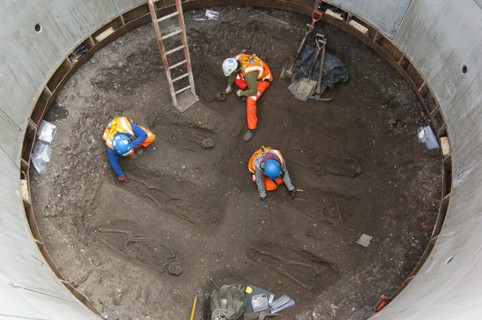
The grout is injected into the ground via a series of small-diameter horizontal underground pipes known as Tubes-a-Manchette (TAM) that radiate from the base of the shaft and can be as long as 80m. ‘In total, 19km of TAMs were drilled at Farringdon,’ said Chartouny.
This compensation grouting process is expected to continue until around three months after all excavation work is complete. After that, assuming there are no problems, the grout shafts will be backfilled and the ground considered stable.
It’s very difficult, in the dusty noisy netherworld beneath Farringdon’s streets, to imagine what it will look like in only a few years’ time. Just as it will no doubt be hard to recall its current state when it opens for business.
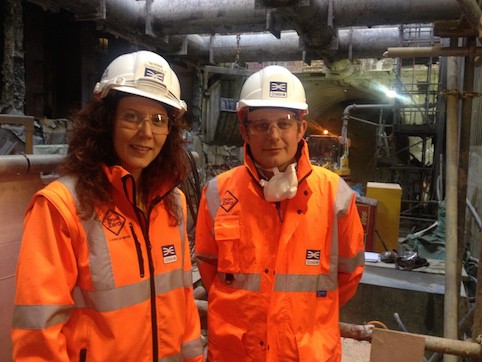
Nevertheless, the station is taking recognisable shape and Chartouny is now looking ahead to its next phase of development. ’By the end of 2014 we’re expected to be done with the bulk of the tunneling and civil work,’ she said, ’and will start transitioning to all the railway systems and station work.’
And despite a palpable site-wide excitement that there’s now light at the end of the tunnel, Chartouny admits that the completion of the project will be a bitter-sweet moment for all involved: the pride of a job well-done tempered by the knowledge that a close-knit team will soon be moving on.




Glasgow trial explores AR cues for autonomous road safety
They've ploughed into a few vulnerable road users in the past. Making that less likely will make it spectacularly easy to stop the traffic for...